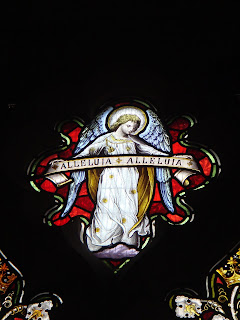
This is sort of technically a Christmas carol, but in The Oxford Book of Carols it's designated a carol for 'January and February', and frankly these months are so in need of a bit of brightness that it's right they should have their own carol. The third verse is the key, but the whole thing fits very appropriately in this inbetween season of the year: speaking of Christ's birth but with a focus on the conquest of death, it looks back to Christmas and forward to Easter at the same time. It makes a difference to read (or sing) a line like "Gladness and salvation... came on Christmas Day" when Christmas Day was a month ago, rather than on the day itself. I often feel it's a shame that Christmas is the subject of so much superb art and poetry and music and yet we only get to enjoy it for a few days (twelve at the most!). There's enough beauty and theology in one collection of carols to occupy the mind and heart for a whole year - for many years - and we rush through them so fast. For this reason, though it isn't yet Candlemas - the traditional end of the Christmas season - I'm happy to have a carol like this one to keep me going.
In case you can't tell, it's dark and cold right now. But the days get longer, and light wins in the end.
The words to this carol are by J. M. Neale, and you can see the sheet music for the tune here- it's from the sixteenth-century manuscript compilation Piae Cantiones. I couldn't find a recording on youtube, but there's a kind of improvisation on it here which is very nice.
1. Earth to-day rejoices,
Alleluia, Alleluia, Alleluia,
Death can hurt no more;
And celestial voices,
Alleluia, Alleluia, Alleluia,
Tell that sin is o'er.
David's sling destroys the foe:
Samson lays the temple low:
War and strife are done,
God and man are one.
2. Reconciliation,
Alleluia, Alleluia, Alleluia,
Peace that lasts for aye;
Gladness and salvation,
Alleluia, Alleluia, Alleluia,
Came on Christmas Day.
Gideon's Fleece is wet with dew:
Solomon is crown'd anew:
War and strife are done.
God and man are one.
3. Though the cold grows stronger,
Alleluia, Alleluia, Alleluia,
Though the world loves night;
Yet the days grow longer,
Alleluia, Alleluia, Alleluia,
Christ is born, our Light.
Now the Dial's type is learnt:
Burns the Bush that is not burnt:
War and strife are done;
God and man are one.
3 comments:
Greetings from wintry Toronto. A friend sang the January Carol in church this morning, and was puzzled by "now the dial's type is learned." Would appreciate any illumination you might be able to shed.
Thank you.
Hello! That's a great question, and I'm not sure I can answer it. My best guess is that 'dial' refers to the cycle of the days through the year, and so it would mean something like 'now we learn to interpret the meaning of the year's cycle' (i.e. that days growing longer represents the coming of light, and Christ).
But I looked for dictionary references for 'dial' in this sense and couldn't find any, so this may be wrong! The alternative is that it has something to do with the kind of 'dial' referred to in the carol 'The New Dial' (http://www.musicanet.org/robokopp/english/anewdial.htm), where it seems to be a kind of mnemonic for religious instruction. But again, I couldn't find many references explaining that idea. It's a bit of a mystery...
Re: Dial as the turning of the year, and Christ as the Type that increases light. Given Neale's education and leanings, your reasoning is sound. It is the only interpretation that I find consonant with Neale and his philosophical language/ theology. I think that you have it right especially since the carol is about the turning of the season as bringing increased light,despite "cold growing stronger" (this wicked world resisting salvation and God's reign). The New Dial (12), 12 days of Christmas, 12 hours of the day, etc. have only this in common - time turning towards more light and/or governed by light. And the would be the only discernible "type". All of which makes this less a "carol" and more a "sacred song" set to a carol tune. And very lovely and meaningful indeed.
Post a Comment